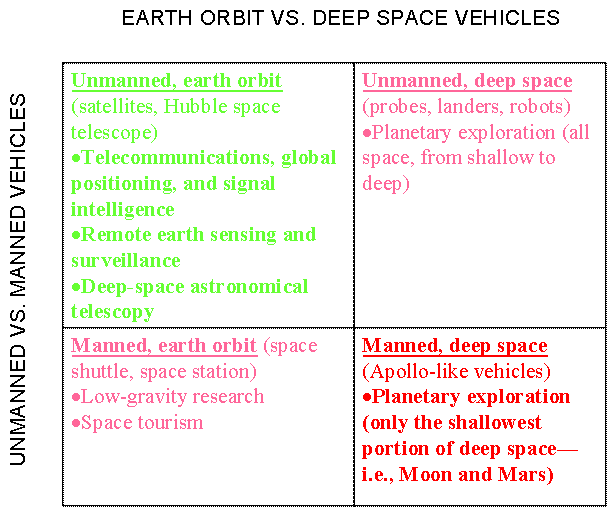more on Fwd: Re: [IP] Hubble Space Telescope Servicing Mission
Delivered-To: dfarber+@xxxxxxxxxxxxxxxxxx
Date: Sun, 18 Jan 2004 17:59:46 -0700
From: James Kobielus <jkobielus@xxxxxxxxxxxxxxx>
Subject: Re: [IP] Hubble Space Telescope Servicing Mission 4
andfuturecancelled.
To: dave@xxxxxxxxxx
Dave:
Re your article ?[IP] Hubble Space Telescope Servicing Mission 4 and
Futurecancelled,? I wish somebody (anybody) in
Washington would present this country's
space-exploitation policy priorities/options in the proper framework.
Here are my thoughts concerning what I feel is the proper
framework:

Fundamentally, our space-exploitation
options and costs are largely a function of the types of vehicles we
propose to launch and maintain. The options are unmanned vs. manned
vehicles and earth-orbit vs. deep-space vehicles. They fall into the four
quadrants presented above:
·
Unmanned, earth-orbit vehicles (e.g.,
satellites, Hubble space telescope)
·
Unmanned, deep-space vehicles (e.g., probes,
landers, robots)
·
Manned, earth-orbit vehicles (e.g., space
shuttle, space station)
·
Manned, deep-space vehicles (e.g., Apollo-like
vehicles)
It seems to me that the vast majority of our high
prioritiestelecommunications, remote sensing, surveillance, global
positioning, and deep-space telescopy-are being addressed just fine by
unmanned, earth-orbit vehicles (the upper left quadrant). As is clear,
these include both practical and pure-science applications of a space
presence. By contrast, the other three quadrants are almost all
pure-science applications, with the frivolous exception of space tourism
(for manned, earth-orbit).
The color-coding of the quadrants serves an important purpose. It flags
the payoff-to-cost ratio (to the U.S. and to
humanity generally) from the space applications in a quadrant. Clearly,
unmanned, earth-orbit vehicles provide a strong net benefit to humanity,
so they?re colored bright green. By contrast, manned, deep-space vehicles
cost a lot, risk human lives, and promise little practical benefit (and
not appreciably more than unmanned, deep-space vehicles). Consequently,
they?re colored bright red (for red ink, i.e., money, and for the red
human blood likely to be shed in such missions). The other two quadrants
are a paler shade of red, showing that they?re primarily cost centers and
don?t offer much practical payoff.
To the extent that we launch manned, deep-space missions, these must be
sold to the American public on the basis of pure national hubris, pure
manifest destiny, and pure science. In other words, as pure symbols
devoid of serious practical benefit.
I personally think that?s an absolute waste of money. Focus on earth,
earth-orbit, and all things that make life on earth more pleasant.
Jim
James
Kobielus
Senior Analyst
Burton Group
6006 John Roccato
Court
Alexandria VA 22310
703-924-6224 (phone and fax)
USA Eastern timezone (GMT-5)--Washington DC area
www.burtongroup.com
"Driving network
evolution"
Hope we can see you at Catalyst 2004.
"SEATTLE//In the
essential/Seattle users//photosynthesize/caffeine directly//from whatever
drops/of liquid sunshine//are vouchsafed their way/or, failing that,
fix//off the glints of glare/that glance in off the//gray and grace their
green/eye-stained monitors." --James Kobielus
"YES//Ah yes the meaning,/the ineffable//chi of words we
don't/understand but love//and into which we/wish to crunch the glow//and
interstellar/gas surrounding the//crucible's melt and/endless spew of
new//formulations and/dumb complexities."--James Kobielus
You are subscribed as roessler@xxxxxxxxxxxxxxxxxx
To manage your subscription, go to
http://v2.listbox.com/member/?listname=ipArchives at: http://www.interesting-people.org/archives/interesting-people/
